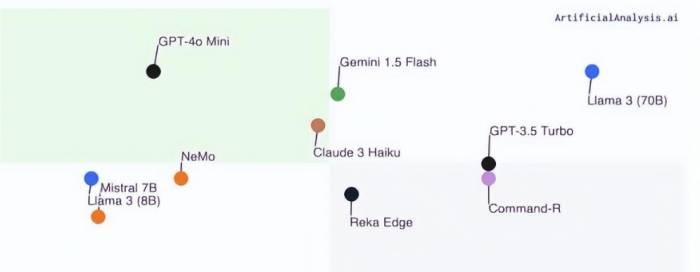OpenAI releases the GPT-4o Mini, on the same day Mistral joins Nvidia to launch
Finally, OpenAI has also stepped into the battlefield of small models.
On July 18th local time, OpenAI officially released the GPT-4o Mini, which is its latest small artificial intelligence model (small model).
The company stated that the GPT-4o Mini is more powerful and cheaper than OpenAI's current most advanced small model. The model will be open to developers and users of the ChatGPT website and mobile application from today, and enterprise users will gain access next week.
If you visit ChatGPT now, you will find that the previous default model GPT-3.5 has disappeared and has been replaced by the GPT-4omini, while GPT-4 has become a Legacy model.
ChatGPT was released at the end of 2022 with GPT-3.5, and today it officially ends, which makes people sigh at the speed of iteration of large models.OpenAI states that GPT-4o Mini outperforms industry-leading small models in reasoning tasks involving both text and vision. Well-known small models include Anthropic's Claude 3 Haiku and Google's Gemini Flash.
With the advancement of small models, they are becoming increasingly popular among developers due to their speed and cost-effectiveness compared to large models, such as GPT-4 Omni or Claude 3.5 Sonnet.
Advertisement
They are well-suited for handling high-frequency simple tasks, where user operations may frequently need to invoke these models in practical application scenarios.
GPT-4o Mini's Cost-Effectiveness
For developers using OpenAI's Application Programming Interface (API), it is priced at 15 cents per million input tokens and 60 cents per million output tokens. This price is more than 60% cheaper than the GPT-3.5 Turbo version released earlier this year."Back in 2022, the best model in the world was still text-davinci-003 (a version of GPT-3)," said Sam Altman, CEO of OpenAI, "It is far from today's latest models and is more than 100 times more expensive."
In the evaluation of Artificial Analysis, the cost-effectiveness of GPT-4o Mini also surpasses a number of popular small models.
OpenAI did not disclose the exact parameter scale of GPT-4o Mini, but said it is roughly at the same level as other small models (such as Llama 3 8B, Claude Haiku, and Gemini Flash).
However, the test scores disclosed by the company show that GPT-4o Mini is faster, more cost-effective, and more powerful than mainstream small models.
Specifically, GPT-4o Mini scored 82% in large-scale multi-task language understanding tests, compared with 79% for Gemini Flash and 75% for Claude Haiku.In a multilingual mathematics test, GPT-4o Mini scored 87%, while Gemini Flash and Claude Haiku scored 78% and 72% respectively.
Additionally, in the HumanEval (code generation) test, GPT-4o Mini also led far ahead with a score of 87.2%, compared to Gemini Flash's 71.5% and Claude Haiku's 75.9%.
It can be seen that GPT-4o Mini's performance in benchmark tests is indeed excellent. Of course, there is still a certain gap between its performance and the large model GPT-4o.
According to the official website of OpenAI, "GPT-4o Mini's context window is 128k tokens, which is roughly equivalent to the length of a book, and each request supports up to 16k tokens, with knowledge updated up to October 2023."
Currently, GPT-4o Mini supports text and visual input in the API. OpenAI stated, "In the future, it will support video, audio, and image generation functions. Its fine-tuning capabilities will also be released in the near future.""In order for every corner of the world to benefit from artificial intelligence, we need to make models more affordable," said Olivier Godement, the head of product API at OpenAI. "I believe GPT-4o Mini has taken a very important step in this regard."
In addition, OpenAI also emphasized that GPT-4o Mini has the same built-in safety measures as GPT-4o.

A lot of toxic content has been filtered out during the pre-training phase, and technologies such as Reinforcement Learning from Human Feedback (RLHF) have been used to align the model's behavior with the company's policies, thereby improving the accuracy and reliability of the model's responses.
Value of Small Models
Small models refer to those models that have significantly fewer parameters than traditional large models and generally have a simpler structure.They are designed to perform simpler tasks at a lower cost, such as making lists, summarizing, or suggesting words, rather than conducting in-depth analysis.
These models are typically aimed at API users who pay a fixed token input and output fee and use these models in their applications.
Smaller models have fewer parameters, which means less computational power is required to run the models, thereby reducing hardware requirements, energy consumption, and ultimately the cost to the end user.
However, there is research showing that there is not always a direct relationship between the number of parameters and capabilities. The quality of the training data, the efficiency of the model architecture, and the training process itself can also significantly affect the performance of the model.
Looking to the future.In the blog, OpenAI stated that it will continue to drive down the cost of models while enhancing their capabilities. It envisions a future where models are seamlessly integrated into every application and website.
In fact, as the field of large models becomes increasingly competitive, many companies are focusing on smaller models, hoping to attract developers with lower costs.
On the same day as the release of GPT-4o Mini, a small model called Mistral NeMo was also released, jointly launched by the French AI unicorn Mistral and NVIDIA.
The model has 1.2 billion parameters and a context window of 128k. Most importantly, thanks to NVIDIA's deep involvement, the model has achieved better performance optimization on the NVIDIA platform.
It is foreseeable that we will see more and more small models emerging, paving the way for developers to build and expand powerful AI applications more efficiently and economically, which will also allow more people to experience the convenience of artificial intelligence.